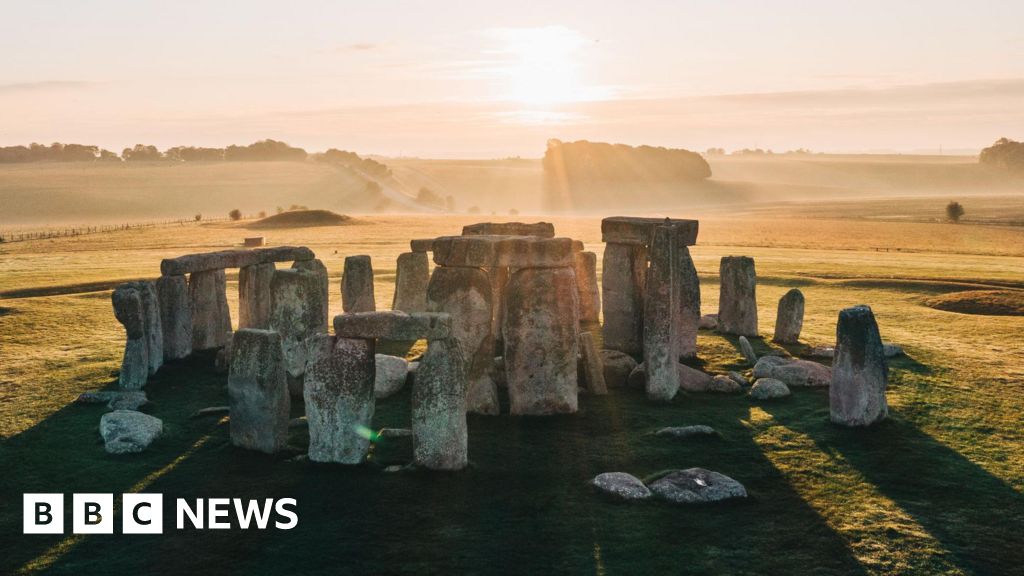Science
New Research Links Stonehenge Cow Tooth to Welsh Origins

New analysis of a Neolithic cow’s tooth discovered at Stonehenge provides significant insights into the origins of the ancient monument. The study suggests that the cow likely hailed from Wales, supporting long-held theories that cattle played a vital role in the transportation of the massive stones that constitute Stonehenge.
The tooth, part of a cow’s jawbone unearthed near the south entrance of Stonehenge in 1924, underwent rigorous examination by scientists from the British Geological Society, Cardiff University, and University College London. Researchers meticulously sliced the tooth into nine horizontal sections to analyze its isotopic composition, which offered clues regarding the animal’s diet, environment, and movement.
The findings reveal, for the first time, a direct link between cattle remains at Stonehenge and regions in Wales during the period when the bluestone megaliths were transported to the site. According to Prof Jane Evans from the British Geological Society, “It is another tie between Stonehenge and Wales… the animal has been grazing on the Palaeozoic rock, typical of those found in Wales, particularly in and around where bluestones are found.” While similar rocks are present in the Lake District and Scotland, the evidence strongly indicates a Welsh origin for the cow.
The study builds on research from 2018 that suggested cattle were likely used to help move the stones rather than relying solely on human effort. “There’s been no evidence that cattle were used as beasts of burden in the Neolithic,” Prof Evans explained, “but that changed in 2018 when there was a paper that showed that oxen had structures in their feet typical of animals pulling additional weight.”
The cow’s jawbone dates back to between 2995 and 2900 BC, a time frame closely associated with the monument’s construction. Its molar, measuring approximately one inch (2.5 cm) in height, grew incrementally, reflecting the animal’s life over six months. The researchers analyzed isotopes of carbon, oxygen, strontium, and lead from the tooth, revealing seasonal changes in diet and indicating that different food sources came from various geological areas. This suggests the cow either migrated seasonally or that its fodder was transported.
Interestingly, the lead isotopes indicated composition spikes during late winter to spring, hinting at an older lead source than that found in the rest of the tooth. “The composition suggests the cow originated from an area with Palaeozoic rocks, such as the bluestones found in Wales, before moving to Stonehenge,” the scientists concluded. Michael Parker Pearson, professor of British later prehistory at University College London, remarked that this adds to the “fascinating evidence for Stonehenge’s link with south-west Wales.”
The analysis also suggested the cow was likely female and either pregnant or nursing during the tooth’s formation. “To me, this was one of the more interesting aspects of the study,” said Prof Evans. This finding shifts the focus to a more domestic perspective on how the stones were transported, indicating that the movement of these massive structures would have involved not only the animals but also the people—potentially including women and children—preparing food and providing support.
Moving the stones from the Preseli Mountains in west and south Wales to Stonehenge would have taken approximately two to four months. “You’ve got to have food supplies and a turnover of people and animals to help with pulling,” Prof Evans noted, emphasizing the practical aspects of the operation.
The research raises further questions about the logistics of stone transportation and the role of the broader community involved in the process. Prof Evans highlighted the often-overlooked contributions of women, stating, “It’s rarely considered that women were involved… Surely they’ve got to have been there, and probably as many women as men, and children.”
As scientists continue to explore the origins of the cattle associated with Stonehenge, they aim to strengthen their conclusions regarding the connection to Wales. “So much research around Stonehenge has been surprising and unpredicted in the last few years,” Prof Evans concluded. “But now we’re looking at people and animals.” The ongoing investigation promises to deepen our understanding of the intricate relationships between the ancient monument, its builders, and the landscape from which its stones were sourced.
-

 Entertainment2 months ago
Entertainment2 months agoIconic 90s TV Show House Hits Market for £1.1 Million
-

 Lifestyle4 months ago
Lifestyle4 months agoMilk Bank Urges Mothers to Donate for Premature Babies’ Health
-

 Sports3 months ago
Sports3 months agoAlessia Russo Signs Long-Term Deal with Arsenal Ahead of WSL Season
-

 Lifestyle4 months ago
Lifestyle4 months agoShoppers Flock to Discounted Neck Pillow on Amazon for Travel Comfort
-

 Politics4 months ago
Politics4 months agoMuseums Body Critiques EHRC Proposals on Gender Facilities
-

 Business4 months ago
Business4 months agoTrump Visits Europe: Business, Politics, or Leisure?
-

 Lifestyle4 months ago
Lifestyle4 months agoJapanese Teen Sorato Shimizu Breaks U18 100m Record in 10 Seconds
-

 Politics4 months ago
Politics4 months agoCouple Shares Inspiring Love Story Defying Height Stereotypes
-

 World4 months ago
World4 months agoAnglian Water Raises Concerns Over Proposed AI Data Centre
-

 Sports4 months ago
Sports4 months agoBournemouth Dominates Everton with 3-0 Victory in Premier League Summer Series
-

 World4 months ago
World4 months agoWreckage of Missing Russian Passenger Plane Discovered in Flames
-

 Lifestyle4 months ago
Lifestyle4 months agoShoppers Rave About Roman’s £42 Midi Dress, Calling It ‘Elegant’









